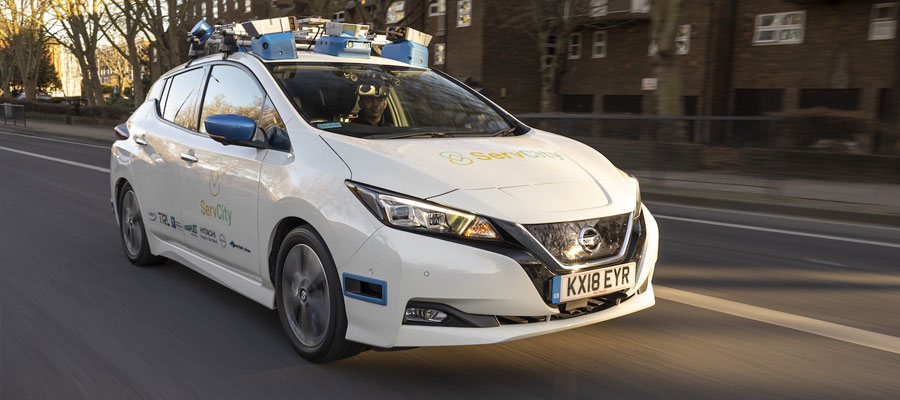Autonomous car development accelerates with UK project

ServCity - a consortium backed by the UK Government and Nissan - has created a blueprint for using Connected and Autonomous Vehicles (CAVs) in urban areas with the culmination of a three year project covering more than 1,600 miles.
Having deployed a Nissan Leaf fitted with autonomous driving systems, the project looked at how autonomous vehicles could be used in busy urban areas.
It lays out foundations as to how cities could factor in “robotaxi” style vehicles that could transport customers around built up areas, by covering 1,600 miles around the streets of Greenwich.
The location was picked since vehicles were able to connect to the Smart Mobility Living Lab (SMLL) in Greenwich. This uses roadside sensors to help construct an environment where the car knows what's going on, even around the corner. By using this data, it can allow the vehicle to operate more smoothly in traffic, such as changing to the correct lane, or avoiding certain busy routes.
Government-backing for driverless tech
The ServCity consortium involves backing from the government's Intelligent Mobility fund, Nissan UK, Catapult, TRL, Hitachi Europe, the University of Nottingham, and SBD Automotive.
The Greenwich project is the latest in a long line of development projects that are looking to make the UK an advanced hub for driverless cars.
Transport Minister Jesse Norman said:
“The Government has invested £7 million in this project to be at the forefront of innovation. Since then ServCity has proven key to answer the practical questions of how to integrate self-driving vehicles into cities for the public good.”
David Moss, Senior Vice President, Region Research & Development for Nissan AMIEO (Africa, Middle East, India, Europe, and Oceania) said: “We are extremely proud to be a part of the ServCity project and our 100% electric Nissan Leaf has proven to be the ideal test vehicle. Through our Nissan Ambition 2030 long-term vision, we are committed to supporting greater access to safe and exciting research projects such as ServCity are vital to the evolution of technology.
“Through our world-class R&D base in Cranfield in the UK, Nissan is continuously innovating to bring cutting-edge, purpose-driven technologies that benefit our customers. ServCity's achievements contribute to our efforts to usher in a future where we hope to see zero fatalities on the road while providing customers with the added comfort and convenience that come from advanced autonomous drive technologies.”
How long until driverless cars reach our roads?
It's the multi-billion dollar question. And the answer is that nobody really knows. It could be 10-15 years away, or even much longer… potentially never. The technical and legal hurdles to overcome before driverless cars reach widespread usage remain significant.
It's unlikely any vehicle will be able to be autonomous anywhere in the world, since the challenges of developing systems for multiple applications are considerable. But vehicles don't need to be designed to work everywhere.
For example, we already see driverless vehicles used in quarries and factories around the world. Systems like the Docklands Light Railway (DLR) has no driver, but are separated from other lines and roads by being kept to rails.
So geo-fencing - physical or using mapping systems - is likely to be the first stage in allowing autonomous driving on our roads.
Incremental applications such as allowing driverless cars on certain sections of motorways or dual carriageways - where all traffic travels in the same direction - could be a first step. Which makes the development of an urban plan all the more impressive.
With multiple junctions in a short space, pedestrians, a lot of traffic, and cramped conditions, urban driverless trips have the greatest potential for chaos; but also the greatest potential for being useful.
By using data from roadside infrastructure, as well as information gained by the car's systems such as cameras, radar, and Lidar, a CAV is more likely to succeed in travelling around an area safely.
View our latest blog posts

Categories
Pages
We are a family run business based in rural Worcestershire. Our team of 38 staff are on hand to provide an exceptional service to personal and business customers.
Read More
